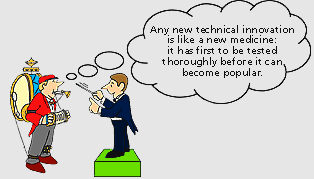|
ATTENTION TO THE "DO IT YOURSELF" METHOD! |

|
A technique starts off and, through time, evolves, until it becomes known by the name of the person who invented it or thanks to whom it was made popular.
Hence we got the "Borg" hold in tennis, the "Hungarian" kick in football and the "Rameau" hand crossing technique in the field of keyboard instruments in music. There are, however, also cases of regression of already established techniques, the causes of which generally lie in do-it-yourself teaching methods. Usually there are two types of scholars: those who trust to what is written in books, and those luckier ones (in the sense that they can afford to go to the ends of the earth) who learn directly at the source. The former, who are the vast majority, can again be divided into two categories: the talented ones, who may not understand all the ins and outs of little known techniques but nevertheless manage to add something new or better to what they have learnt through such an incomplete means of communication as the book; and the untalented ones, who add a personal, though negative, touch to what they are unable to understand or assimilate. It is therefore more or less obvious that those last mentioned - healthy carriers of defective viruses - are a real danger, even when they are not well-known, to unfortunate students who turn to them unawares. The act of sounding a percussion instrument is fundamentally an instinctive thing, which is often questioned by those who launch into scientific analyses without having the slightest competence, merely confusing people's ideas. We are all able to read up on anatomy and write complicated things about wrist, finger and arm movements - all of which, if it doesn't actually do harm, just serves to make a naturally fluid action into something mechanical. Splitting up technique into too many details, no matter what those details are, often means blocking instinctive movements which are the basis of the act and art of sounding percussion. More than forty years of playing, observing and tutoring percussionists of all ages and levels have enabled us to look for, and gradually develop, a new teaching technique which was not only suitable for all the principal percussion instruments but also allowed those using it to achieve maximum results with minimum effort. The first thing we were able to establish was that all those who came to us for help had many defects in common, such as, for example, movements that were too mechanical - the result of trying to imitate players seen on television, or of a surfeit of trite slogans like, for example, "The mallet is an extension of the hand (or the fingers)". Later, face to face with a keyboard and playing a simple multiple octave scale, they begin to roam around awkwardly, trying to reach the keys to be struck, by moving their whole body. This gave us the idea of developing a no-frills playing method based mainly on instinct and natural control of the mallets. A universal technique that anyone at all, without any need to imitate anyone else, can personalise by adding his or her own talent. The main problem for any keyboard percussionist is to obtain a good sound and a clear-cut technique, even when playing at speed, without effort and without the traumas caused by excessive tension of the articulations. After many years of tutoring experience, followed by careful analysis of the results, we can affirm that this is no longer a problem for those who have studied our method which began with "Il suono della percussione" (the sound of percussion), published by Curci in Milan in 1982, and which was put onto film in the video (DVD) "Percussion And Drums School" issued by Curci in 1996. |